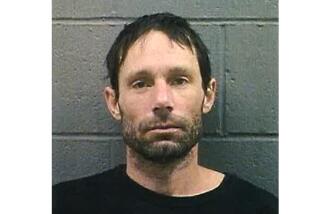DNA Data Helps Convict Buena Park Man of 8 Rapes : Trial: He faces up to 160 years in prison. Jurors call evidence from ‘genetic fingerprinting’ pivotal.
- Share via
SANTA ANA — A Superior Court jury Monday convicted a Buena Park man of raping eight women while committing a series of burglaries that took place during a 2 1/2-year span.
Danny Harris, 42, quietly shook his head at times as a court clerk read for almost an hour the guilty verdicts to all 28 counts of rape, burglary and attempted rape.
Prosecutors alleged that Harris raped eight women--two of whom were attacked twice--from December, 1985, to July, 1988. The attacks all happened during the night and early morning hours to women who lived alone on ground-floor units. The victims ranged in age from the late 20s to their 80s.
Harris faces up to 160 years in prison when he is sentenced Aug. 21, prosectors said.
The verdicts returned by the jury of six women and six men were a victory for the still relatively new DNA “genetic fingerprinting” that prosecutors now use in trials to link a suspect with a crime when witness testimony and other evidence are not strong enough. DNA, or deoxyribonucleic acid, is the basic material of life and contains an individual’s genetic code.
The defendant’s attorney, Christian R. Jensen, argued that DNA tests are still new, so their findings should not be admitted as evidence. He also questioned the inconsistencies of the victims’ testimony.
The eight women Harris raped all testified, but some of the testimony was either conflicting or unclear. Two victims testified that they thought their attacker was a Latino. Four women were unable to give a description or the race of the man who attacked them. Harris is black.
However, prosecutors introduced DNA tests showing that Harris’ blood and semen samples matched fluids left behind at the crime scenes.
Jurors said their verdict was based almost solely on DNA evidence.
“The DNA evidence was overwhelming,” said jury forewoman Marla Fenwick, 45, who declined to give her city. “The fact that there were nine sets of (DNA sample patterns), and they all match with Mr. Harris--that’s just impossible to defend against.”
Another juror, Marvin Olsen, 58, of Santa Ana, said he based his decision on the validity of DNA tests and tried to distance himself from the violence of the attacks.
“Without DNA evidence, there clearly was no case,” he said. “We became numbed by the number of witnesses and the story they had to tell, but it wasn’t the great decider of the case.”
Initially, prosecutors alleged that Harris burglarized and raped at least 25 women, most of whom lived in North County. But because of a time delay because of lengthy court procedures, some victims--many of whom were elderly--could not be found or had died.
Harris was arrested in late 1988 during a botched burglary in Garden Grove.
On Monday, Deputy Dist. Atty. Dennis D. Bauer praised the jury’s decision, saying the verdicts might be a sign of what future trials involving DNA could produce.
Harris’ body samples collected by DNA experts in 1989 were done in “a primitive” manner, compared with what could be achieved by today’s technology, Bauer said.
“If this case--using primitive evidence--was easy for jurors to understand, then cases with much better procedures should be much easier to present to jurors in the future,” he said.
Bauer dismissed the defense’s contention that the DNA evidence was not trustworthy.
“That’s their best shot,” he said. “They try to cast (doubt) on DNA evidence. This evidence is so strong and so accepted within the scientific community they can’t realistically challenge it.”
As to the discrepancies of the victims’ testimony, Bauer said the women who could not correctly describe Harris probably could not do so because the attacks happened in the dark.
In a few instances, the attacker would speak in a false accent, calling his victims senorita and telling them he was Latino, Bauer said.
Times staff writer Mait Lait contributed to this report.
More to Read
Sign up for Essential California
The most important California stories and recommendations in your inbox every morning.
You may occasionally receive promotional content from the Los Angeles Times.










